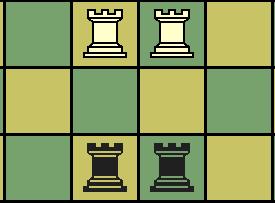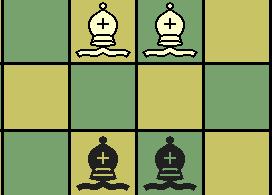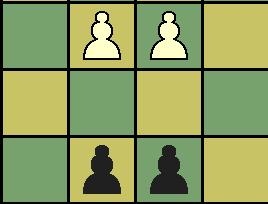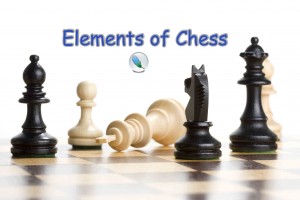You can read Elements of Chess Part 1 here

You may recall that each player is provided with 16 pieces at the beginning of the game. The sixteen pieces are as follows:
- One King
- One Queen
- Two Bishops – one in white and one in black
- Two Knights
- Two Rooks
- Eight pawns
Before going further, I would like to state that not all chess pieces are created to be equal. Some pieces are more valuable than the other pieces and these pieces gain their importance or strength depending upon their mobility. Except the King, which is of infinite importance, all the other pieces have been assigned some value depending upon their significance and mobility.
Let me now explain each of these pieces, their scope of movement in the chessboard, their value in the chessboard and their notation in chess parlance.

King
The King is the supreme power in the game of chess and the mission of the game in chess is to capture the king of the opposite player and vice versa. The King is the slowest moving piece, even slower than the pawns, but the most valuable one in that if King is lost, then the game is over. As the king is the important piece in the game and the capture of the king ends the game, there is no point assigning a special value to the King to signify the importance of that piece. Hence, the King has no specific value to assign. All other pieces have some value depending upon their importance and capability of movement
In the chessboard, the white king is placed in the “first” rank of “e” file – that is “e1”. Similarly, the black king is placed at the “eighth” rank of “e” file – that is “e8”. You may notice that the white king is at the black square and the black king is at the white square.
In chess parlance, the King is assigned the capital letter “K”. You know that the white king is placed at “e1”. If you move the King one step forward to the second rank, it will be denoted as “Ke2” – indicating that the King has moved from the existing position to “e2”.
The King can move only one square in any direction. It cannot move more than one square in any direction in the normal course of the game. There is only one exception to this rule. When a player resorts to Castling, which I will explain to you a little later, the king is allowed to move either two spaces to the left or three spaces to the right depending on the side on which castling is resorted to by the player.

Queen
The most powerful piece in the chessboard is the Queen. The Queen has been assigned a value of 9, the highest value for any piece in the chessboard. Since Queen is the most important piece other than the King, it has more capabilities that other pieces and as such needs to be handled very carefully. Losing the queen will not result in the loss of game as such, but the capabilities to attack as well as defend in case of counter-attack will be greatly reduced if you lose the queen in the course of the game.
Before knowing about the movements of the game, let me explain to you where it should be placed in the chessboard at the time of starting the game.
The Queen is placed adjacent to the King on the left hand side. The white Queen, as such, will be placed at the “first” rank of file “d” – that is “d1”. The black Queen will be placed at the “eighth” rank of file “d” – that is “d8”. The White queen is placed in the white square and the black queen is placed at the black square.
The queen is one piece in the chessboard that can move in any number of unoccupied squares vertically, horizontally or diagonally. None of the pieces, except the Knight, can jump on top of the other pieces. They can move only on unoccupied squares. The queen, starting from “d1” can move either horizontally to “a1” or “h1”, move vertically up to “d8” or move diagonally to “c2”, “b3”, or “a4” on the left hand side or to “e2”, “f3”, “g4”, and “h5” on the right hand side, provided there are no pieces on any of these squares.
In chess notation, the queen is assigned capital letter Q. For example, if queen moves from “d1” to say “g4” diagonally, then it is represented as Qg4.

Rook
The second important piece in the chess board, next to the king and queen, is the rook. In fact, each player is provided with two rooks. Each rook has been assigned a value of 5, the second highest value for a piece in the chess board.
In the beginning, the two rooks are placed at two corners in the first rank for a player using white pieces and at the two corners of eighth rank for the player using black pieces. In other words, the white rooks are placed at “a1” and “h1” respectively, while the black rooks are placed at “a8” and “h8” respectively.
The rook can move any number of unoccupied squared either vertically or horizontally only. It cannot move diagonally. For example, if the rook is in fourth rank of “d” file, it can vertically move anywhere along the “d” file or horizontally across the fourth rank.
In chess notation, the rook is assigned capital letter R.

Bishop
The next piece in the game of chess, which is not as important as the Rook or the Queen, is the Bishop. Each player is provided with two Bishops. The specialty of these bishops is that they can move only in that color which is assigned to them at the beginning. As such, they cannot move into the square in the other color. Each bishop is assigned a value of 3, lesser than the value of a rook.
In the beginning, the two bishops are placed adjacent to the King and the Queen, in the first rank and eighth rank for the white and black pieces respectively. You might recall that the White King will occupy the black square and the black king will occupy the white square. As such, for the white pieces, the bishop adjacent to the King will be placed in the white square at “f1”, and for black pieces, the bishop will be placed in the black square adjacent to the King at “f8”. Similarly, for white pieces, the second bishop will be placed to the left of Queen in the black square at “c1”, and for black pieces, the second bishop will be placed in the white square at “c8”.
Now, here comes the specialty of the bishops. The bishops can move any number of unoccupied squares, either forward or backward, only diagonally. They cannot move either horizontally or vertically. For the white pieces, the bishop adjacent to the king in the white square at “f1” can move only in the white diagonals and cannot move in diagonals of the other color. Similarly, the bishop adjacent to the Queen at “c1” can move only through the black diagonals. The same thing applies to the black pieces and the two bishops placed at “c8” and “f8” respectively can move diagonally only in squares of the same color.
In chess notation, the bishop is assigned capital letter B.

Knight
The next piece in the game of chess is the Knight. Each player is provided with two knights. In terms of value, each knight is treated at par with the bishop and as such is assigned a value of 3. Just as the rook and the bishop have special features, the knight also has special features as well.
In the beginning, the two knights are placed in between the rook and the bishop on either side of the King and Queen, which occupy the two centre places in the first and eighth ranks respectively. For a player using white pieces, the two knights are placed respectively at “b1” and “g1” respectively in the first rank, while for the player using black pieces, the knights are placed respectively at “b8” and “g8” respectively at the eighth rank.
The moves of the knight are very peculiar. It can move neither diagonally as do the bishops, nor move horizontally or vertically as can the rooks do. The movement of the knight can be best described as a one-two approach. Either the knight can, in one single move, either move one square horizontally and two squares vertically adjacent to the horizontal square, or move one square vertically and two moves horizontally adjacent to the vertical square. Let me make it clear with an example. We know that one knight is placed at “b1” in the beginning. The first move of Knight can be to “c3” – that is one move vertical, which is “b2”, and two moves horizontal – “c2” and “c3” – the third square being the destination square – that is “c3”. The knight may be also moved to “d2” if there is no piece in “d2”. In this case, the knight moves one move horizontal – that is ”c”, and the next two moves are horizontal – “c2” and “d2”.
For the move to be completed, it is essential that the destination square must be an unoccupied one. The knight is the only piece that can jump over the other pieces that lie in between the original square and the destination square. One more important thing to be noted is that while moving the knight, the color of square is important. If the knight is presently in a white square, it can move only to a black square and cannot move to another white square.
In chess notation, the knight is assigned capital letter N. Some people also refer to the knight as ”Kt”, but I prefer using “N”.

Pawn
The last of the different types of pieces in the chessboard is the “Pawn”. Eight such pieces are assigned to each player. The player using white pieces must use the second rank, while the player using the black pieces can use the seventh rank, to place the eight pawns given to each of them. Each pawn is assigned a value of 1.
Though pawn is the least powerful piece in the chessboard, it has some unique characteristics. Pawn is the only piece that cannot move backwards. All other pieces can move either forward or backward. The pawn may move either one or two squares forwards on its first turn, but afterwards it can move only one square at a time. Another interesting feature of the pawn is that it captures the opposite side piece in a way different from the way it moves. In other words, the pawn captures enemy pieces only diagonally.
For example, if there is a pawn in e4, it can capture any piece lying at “d5” or “f5” only and cannot capture a piece in “e5”. Hope I have made it clear to you now.
No letter is assigned to the pawns, while recording chess notation. Only the designation of the square, such as e5, d3, is mentioned in the notation. If only the designation is mentioned, we can presume it to be the pawn movement.
Conclusion
Now, we have understood the basic elements of chess and their relative importance.


